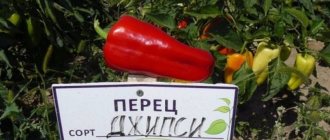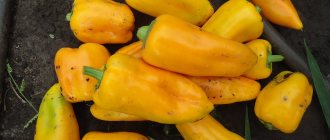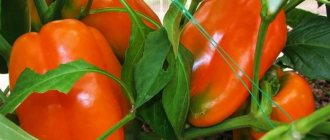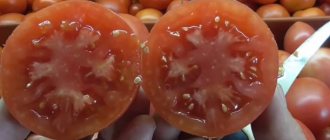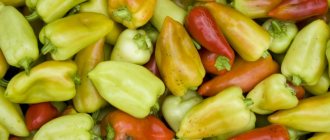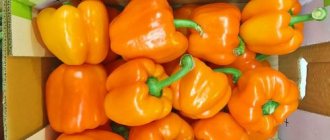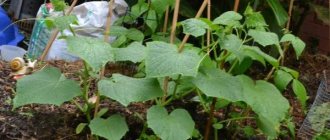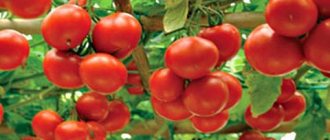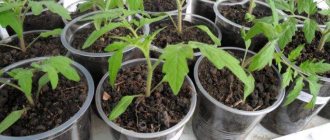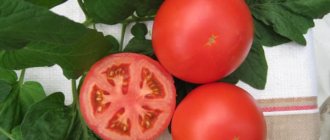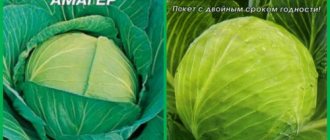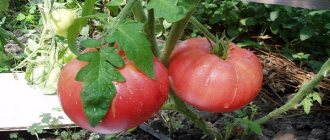Every gardener wants to get a beautiful, rich and tasty harvest from his plot. Pinocchio pepper allows you to achieve all these goals. The hybrid has gained wide popularity among lovers of this variety of vegetable crop. By the end of the growing season, the plant produces large, elongated, red fruits. Despite the early ripening period, peppers have excellent taste with a pronounced peppery aroma.
Characteristics and description of the Buratino variety
Hybrid Buratino is an early ripening pepper. The yield of the harvest at the stage of technical ripeness occurs after 88-100 days. The countdown of the time of fruit appearance should begin after the seedlings have fully germinated.
The height of the plant varies between 0.7-1 m. The bush is spreading and does not require formation.
Characteristics and description of Buratino pepper F1:
- shape – elongated cone;
- fruit length – 15-17 cm;
- diameter – 6 cm;
- wall thickness – 0.5-0.7 cm;
- weight – 80-120 g;
- the pulp is juicy and aromatic;
- peel color – at technical ripeness it is dark green, at the stage of full ripening it changes to bright red (see photo).
The hybrid is a high-yielding one: with proper agricultural technology, from 1 sq. m. get 10.5-13.5 kg of vegetables.
Pepper has a salad purpose and is also used in canning. Fruits contain increased amounts of ascorbic acid (vitamin C)
The plant is planted in the ground using the seedling method. The hybrid is suitable for growing in heated and unheated greenhouses, greenhouses and beds not protected by shelter.
Reviews
Larisa from Tula. Peppers were grown in a greenhouse. On the advice of a friend, I removed unripe fruits. As a result, I got a decent repeat harvest. Peppers were eaten raw, added to salads, and stored for the winter. In all forms, the variety has an amazing taste and aroma.
Valentin from Leningrad region. I saw a photo online of a pepper bush, hung with bright, large fruits. I found the seeds and grew the seedlings myself. At the end of spring I planted the plants in the greenhouse. Provided maximum care. As a result, I got spreading bushes, on which at the end of June there were dark red peppers.
Pepper Buratino F1 will not let you down under any circumstances. It’s worth taking the time and putting in a little effort so that delicious, juicy fruits appear on the table early.
Timing of sowing seeds
Pepper Buratino F1 is sown for seedlings at different times. Planting time for central Russia depends on the place in which the hybrid will grow:
- spring heated greenhouses - end of February;
- unheated greenhouses – mid-March;
- open ground - early April.
After sowing in boxes or individual pots, the peppers are removed to a dark, warm place, covered with film or glass. The optimal place for germination is from +23 to +25 degrees.
It is necessary to constantly ensure that the soil does not dry out. Ventilation is carried out periodically by removing the covering material from the plantings.
As soon as the grains begin to hatch, the peppers are placed in a well-lit place. The film is removed immediately with the appearance of the first shoots so that the sprouts do not burn.
The manufacturer recommends picking in the phase when one true leaf appears on the plants. If the seedlings were planted in separate containers, the procedure is not required.
Resistance to diseases and pests
The plant is resistant to blossom end rot and tobacco mosaic virus. In relation to other nightshade diseases, it behaves like other peppers - it resists them well with good care and compliance with the rules of agricultural technology.
To avoid infections, it is advisable to plant peppers on fresh soil - no earlier than 3-4 years after growing nightshade crops, and when cultivating peppers in a greenhouse, carry out antifungal treatment of all its structures and soil after harvesting.
To prevent diseases, it is recommended to treat peppers with phytosporin or Bordeaux mixture.
Pests that damage the aerial parts of peppers - aphids, mites, slugs - can be controlled using insecticidal preparations, however, when growing small volumes of plants, repelling these insects is usually used by planting basil, calendula, marigolds or spraying with various repellent infusions (birch tar , dandelion, garlic).
To destroy underground pests - wireworms and cockchafer larvae - you have to dig up the soil before planting and remove them manually.
Planting in the ground and care
Pinocchio seedlings are planted in a permanent place at the age of 70 days. Plants are moved to open ground on June 10-15, to unheated greenhouses on May 15, to protected heated ground in mid-April.
The best predecessors of vegetable crops are carrots, beets, cabbage, and all legumes with the exception of beans. You cannot plant peppers near cucumbers.
The recommended planting pattern is 50 by 35 cm. The optimal number of bushes per square meter is 5 plants.
The plant does not require mandatory formation. Despite this, the manufacturer recommends removing the stepsons. The bush may require garter due to the abundance of fruits and the sufficient height of the plant.
Proper agricultural technology for Pinocchio sweet peppers includes regular watering and weeding, loosening the soil and applying mineral fertilizers. Only in this case can you count on good growth and abundant fruiting of the hybrid.
The first feeding is carried out 2 weeks after planting at a permanent place of growth. The fertilizer is prepared from urea and double superphosphate: 10 grams are needed for 10 liters of water. and 25 gr. dry matter, respectively. Consumption per bush – liter of solution.
What kind of pepper is this
Pinocchio is a high-yielding early hybrid, perfectly adapted to temperate latitudes . Large-fruited peppers are valued for their taste and look colorful in winter preparations. Caring for the crop will not be difficult.
Characteristics and description
The hybrid is resistant to the most common nightshade diseases. Tolerates heat, rainy weather, and lack of light. It is grown in greenhouses and open ground. The best harvest is produced in temperate latitudes.
Semi-determinate plant (reaches 1 m in height). The bushes have weak branches (2-3 shoots), but look spreading. The leaves are small, dark green.
Reference ! Semi-determinate crops stop growing at a certain point and are limited in growth. Their main advantage is early maturity.
Hybrid F1
If in the southern latitudes there are no problems with cultivation, then in the middle zone F1 hybrids must have specific qualities:
- ability to grow in open ground;
- ease of care;
- fast ripening times;
- unpretentiousness to weather conditions.
Pinocchio meets these requirements.
Distinctive features
Hybrid pepper Pinocchio has a number of features:
- good germination;
- resistance to tobacco mosaic, blossom end rot;
- long-term fruiting and storage;
- drought resistance;
- ability to grow in shaded areas.
Fruit characteristics, yield
Ripe fruits are red, large (about 17 cm in length and 8 cm in width), cone-shaped, with slight ribbing. The weight of each is 100–120 g, the wall thickness is 4–5 mm, the skin is dense.
Peppers are juicy, sweetish, and can be stored for a long time. The sugar content in them is 3.9%. Productivity is high: up to 13 kg per 1 m2.
Advantages and disadvantages of the variety
Based on the reviews left about the bell pepper Buratino, the following advantages can be highlighted:
- bears fruit from July to September;
- cold-resistant and heat-resistant;
- does not require the formation of a bush;
- gives a stable harvest;
- resistant to major nightshade diseases;
- has a long shelf life and good transportability;
- has a universal purpose and high taste.
Among the disadvantages, gardeners point out the need for staking bushes and the impossibility of growing from your own seeds. Also, some users note a low germination rate of seed and low yield, despite the manufacturer’s assurances.
The main competitive advantage of Pinocchio over other hybrids and varieties is its juicy and very sweet taste with a peppery aroma. Thanks to this advantage, vegetable growers buy its seeds from year to year.
Growing seedlings
Seedlings are first germinated in a common container and then planted, or they are immediately planted in separate containers.
With a pick
The seeds are planted in boxes and covered. Ground temperature - +15 °C. The emerging seedlings are provided with good lighting and regular ventilation. Constantly monitor soil moisture. The film is removed after 14 days and mineral fertilizers are applied.
Important! The seedlings are additionally illuminated with phytolamps, since there is not enough natural sunlight for the plants at this time of year.
After the appearance of 2 pairs of true leaves, picking is carried out. Seedlings are moved into cups, preferably peat cups. The room temperature is maintained within +25…+27 °C, but not lower than +20 °C. On the eve of planting in the ground, the crop is gradually taken outside, strengthening its adaptation to new conditions.
Without picking
This growing method is less traumatic for the delicate roots of peppers. Place 2 seeds in separate cups at once. One of the sprouts (the weaker one) is subsequently removed. After 4 true leaves appear, the plants are transferred to larger pots.
Similar pepper hybrids
In terms of characteristics and descriptions, Pinocchio pepper can be compared with the following hybrids:
- Fisht;
- Samander;
- Gypsy;
Fisht F1 is an early ripening hybrid. Fruit ripening occurs 50-60 days after planting the plants in a permanent place. The peppers are cone-shaped, very thick-walled - up to 1 cm, but in some cases, according to the originator, the thickness can reach 2 cm. The plant is resistant to verticillium, tolerates heat and moisture deficiency well.
Samander F1 is an early-ripening, low-growing hybrid. It is distinguished by its high yield: up to 20 fruits are formed on 1 bush. Peppers are cone-shaped, dense, with a wall thickness of 6 mm, a length of 15-18 cm and a diameter of up to 6 cm, 2 or 3 chambered. The weight of one fruit is 110-120 g. Tolerates adverse weather conditions well.
Gipsy F1 is a hybrid with a ripening period of 85-90 days from the beginning of the growing season. Productivity is low: up to 4.2 kg. from the bush. The plant has stable immunity to the complex of nightshade diseases. At the stage of full maturity, the fruits acquire a rich red color. They have a conical shape, the wall thickness does not exceed 8 mm. Pepper length is 13-15 cm, weight is on average 120 g.
Harvest and storage
To increase the harvest of fruits, gardeners recommend that when the fruits ripen to technical ripeness, they should be removed. This makes it possible to provide nutrition to other fruits and ultimately increase the overall yield.
To preserve peppers for as long as possible, it is necessary to comply with their storage conditions:
- Ripe peppers are well preserved in the refrigerator (humidity no more than 90%, temperature +2 degrees). At the same time, it is impossible for spoiled peppers to come across in the total mass, as this can cause rotting of all the other fruits. Ripe fruits (intact) can last up to 2-3 months.
- For storing green peppers, a humidity level of 90-95% and a temperature of 8-10 degrees are suitable, which can be ensured by placement in basements and cellars. Storage under these conditions can last up to 3 months.
- Content of green pepper at temperatures above 10 degrees. and humidity of 90-95% will allow them to ripen within 25-30 days.
- To improve the quality of storage, peppers are laid out in boxes in one layer, each fruit being wrapped in paper.
Hybrid description details
Bell pepper Buratino F1 was bred in 1995 by vegetable growers from the Moscow Agricultural Academy. Since that time, the variety has been included in the breeding State Register. Pepper is approved for planting in the 1st and 2nd light zones. Growing method: open ground or greenhouses of any configuration.
The plant is a tall, semi-determinate, spreading, but limited branching bush. The number of side shoots is 2-3 pcs. Culture does not need to be formed. Pepper leaves are small and dark.
The fruits are large in size, slightly ribbed, as in the photo. At the stage of technical ripeness - dark green. They turn red later. The wall thickness is about 5 mm.
Attention! The seeds of this hybrid are today produced by TM Manul and Aelita.
Reviews from gardeners about pepper Buratino F1
The reviews left about Pinocchio pepper on forums and review sites are contradictory. Some are completely satisfied with the hybrid, others complain about the difficulty of germination and low yield.
“I read a lot of flattering comments about Pinocchio peppers. I decided to plant the seeds. Out of 20 seeds, only 7 sprouted, 2 seedlings of which died. Otherwise, I have no complaints about the variety. He was not sick with anything, and in July he already began to produce his harvest. I really liked the hybrid for its taste. I have never seen such delicious early ripening peppers. Great for use in fresh salads. Despite the low germination rate, I will try to plant it again next year. Maybe you just got some low-quality seed. Now I will be more picky in choosing seeds, they seem to praise pepper from the Aelita company for this variety.”
“I’ve been growing Pinocchio in open ground for three years now. I really like this hybrid for its excellent peppery taste. Its yield is quite average, and is far from the manufacturer’s assurances. From 1 sq. m. comes out to no more than 5 kg. But it is worth paying tribute to the variety in terms of care. He is unpretentious and has never given me any pain. I plan to continue planting it on my plot.”
“Good, solid pepper. I have been growing it in a greenhouse for several years now. Pinocchio is one of the first to ripen among the early varieties, which is why I like it. Many people complain that this hybrid bears little fruit. To increase productivity, I recommend that gardeners carry out pinching and be sure to apply fertilizer 3 times per season. Then the plant will definitely please you.”
The hybrid variety Pinocchio is loved by vegetable growers for its excellent taste, resistance to disease and ease of care. The vegetable is ideal for preparing salads and canning. With proper agricultural technology, it brings a stable, early harvest.
